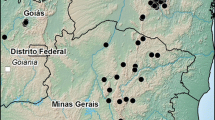Abstract
During herbarium studies for the Flora of Cuba, a new species was found, Parapolystichum villosissimum, which is here described. The species is endemic to Cuba and known from only four collections from the mountain ranges of southeastern Cuba. The last specimen collected was made over 90 years ago. Recent efforts to relocate this species were unsuccessful, suggesting that it should be treated as threatened. The new species is described, illustrated, and compared to the most similar species. A key to the Neotropical species of Parapolystichum is also provided.
Resumen
Durante estudios de herbario para la Flora de Cuba, una nueva especie fue encontrada, Parapolystichum villosissimum, la cual se describe aquí. La especie es endémica de Cuba, con solo cuatro colecciones conocidas de las cordilleras del sudeste de Cuba. El último espécimen fue recolectado hace más de 90 años. Esfuerzos recientes para reubicar esta especie no tuvieron éxito, lo que sugiere que está amenazada. La nueva especie se describe, ilustra y compara con las especies similares. También se presenta una clave para las especies neotropicales de Parapolystichum.



Similar content being viewed by others
Literature cited
Bachman, S., J. Moat, A. Hill, J. de la Torre & B. Scott. 2011. Supporting Red List threat assessments with GeoCAT: Geospatial Conservation Assessment Tool. ZooKeys 150: 117–126.
Bachman, S. & J. Moat. 2012. GeoCAT - an open source tool for rapid Red List assessments. Botanic Gardens Conservation International vol. 9, No 1.
Gardner, J. J. S., L. Perrie, L. Shepherd & N. S. Nagalingum. 2017. Taxonomic placement of unassigned species of Lastreopsid ferns (Dryopteridaceae) using phylogeny. Systematic Botany 42: 385–391.
IUCN. 2012. IUCN Red List Categories and Criteria: Version 3.1. Second edition. IUCN, Gland, Switzerland and Cambridge, UK. Available at http://www.iucnredlist.org/technical-documents/categories-and-criteria.
Labiak, P. H., M. A. Sundue, G. Rouhan, J. G. Hanks, J. T. Mickel & R. C. Moran. 2014a. Phylogeny and historical biogeography of the lastreopsid ferns (Dryopteridaceae). American Journal of Botany 101: 1207–1228.
Labiak, P. H., M. A. Sundue, G. Rouhan & R. C. Moran. 2014b. New combinations in Lastreopsis and Parapolystichum (Dryopteridaceae). Brittonia 67: 79–86.
Labiak, P. H., M. A. Sundue, G. Rouhan & R. C. Moran. 2015. Rhopalotricha, a new subgenus of the fern genus Lastreopsis (Dryopteridaceae). American Fern Journal 105: 20–30.
Prado, J. & R. C. Moran. 2016. Monograph of the West Indian fern genus Polystichopsis (Dryopteridaceae). Brittonia 68: 1–24.
Sundue, M. S. & W. Testo. 2016. Parapolystichum novoguineensis (comb. nov.; Dryopteridaceae) from New Guinea. Phytotaxa 243: 193–196.
Tindale, M. 1965. A monograph of the genus Lastreopsis Ching. Contributions from the New South Wales Herbarium, Flora Series 211: 59–78, tab. 1–23.
Acknowledgements
We thank the Botanic Garden and Museum of the Free University of Berlin for providing all the facilities to develop the taxonomic work, particularly to Dr. Thomas Borsch, Dr. Susy Fuentes and Dr. Werner Greuter. We thank the BR Herbarium for allowing us to reproduce the image of the type specimen, and the New York Botanical Garden for allowing us to use their imaging facilities at the Pfizer Plant Research Laboratory. SEM images of the spores were taken by Robbin C. Moran and Judith G. Hanks, who kindly allowed us to use them in our publication. This work was funded by a grant from the Botanic Garden and Museum of the Free University of Berlin to C.S. in 2013 and by the New York Botanical Garden in 2015, and also by a grant to P.H.L. from CNPq (Proc. 307514/2016-1), and by the “Living Fern Studies Grant” at the NYBG.
Author information
Authors and Affiliations
Corresponding author
Rights and permissions
About this article
Cite this article
Sánchez, C., Labiak, P.H. Parapolystichum villosissimum (Dryopteridaceae): A new and threatened species from Cuba. Brittonia 71, 235–241 (2019). https://doi.org/10.1007/s12228-019-09566-z
Published:
Issue Date:
DOI: https://doi.org/10.1007/s12228-019-09566-z




